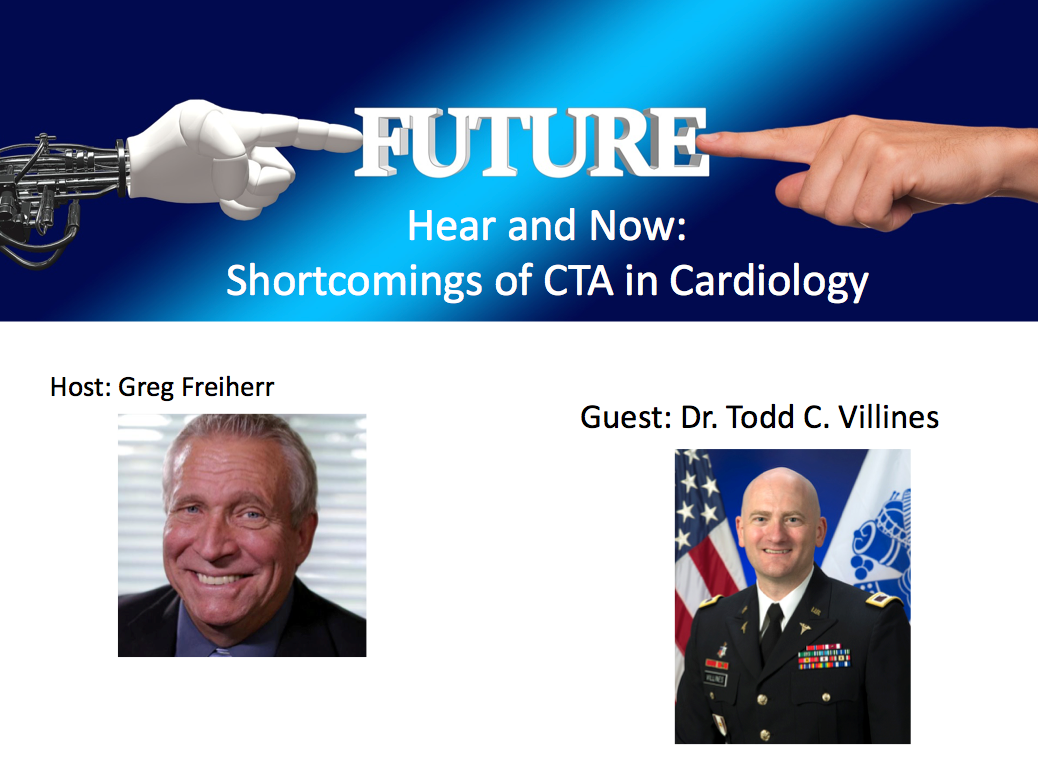

Can computed tomography (CT) angiography accurately measure fractional flow reserve (FFR)? Even if it can, is CT-derived FFR worth the cost?
Todd C. Villines, M.D., FSCCT, director of cardiovascular research and cardiac CT programs at the Walter Reed National Military Medical Center in Bethesda, Md., says “yes” — but only under very specific circumstances.
In an Imaging Technology News (ITN) podcast, Villines stated that CT-FFR is indicated in patients symptomatic of coronary artery disease — but only if they have intermediate stenosis with a coronary lesion seen on CT and the alternative is taking the patient the cath lab. Then, he said on the podcast, there “is a clinical role for CT-FFR.”
CT-derived FFR, which enables combined anatomic and hemodynamic assessment of a coronary lesion by a single noninvasive test, may be viewed as a way to get information about coronary artery disease without the invasiveness of coronary X-ray angiography. Villines described it in the ITN podcast as reasonably but not perfectly accurate. “Probably its biggest limitation, clinically is just using it in a binary fashion like we do invasive FFR. There is probably a wider gray zone,” he said.
Watch an interview with Villines in the VIDEO: Trends and Advances in Cardiac CT Technology.
Debating the Value of CT-Derived FFR At ACC19
Villines will be speaking Saturday, March 17, at the 2019 annual meeting of the American College of Cardiology in a debate over the effectiveness of CT-derived FFR. His main takeaway point, he said in the podcast, will be that CT-FFR is “an exciting technology that I think can serve to enhance the diagnostic yield of coronary CT.”
When compared with invasive FFR, CT-FFR may be “very accurate” when patients are clearly normal or abnormal, according to Villines. It’s when they enter the “gray zone” that the cutoffs used to assess patients with invasive FFR may not apply. For example, cardiologist who assume that every CT FFR above 0.8 indicates “normal” are in danger of error, he said. Values, for example 0.81, 0.82, or 0.83 might not have the same weight as metrics delivered by invasive FFR. “What you would use as a cutoff for abnormal FFR in the cath lab, (might not apply) to CT-FFR,” he said in the podcast.
CT FFR should be used selectively. “I probably wouldn’t recommend performing CT-FFR in very distal vessels, lesions in small branch vessels — lesions where medical therapy is preferred anyway.”
Villines urged cardiologists to “be good stewards,” noting that the current (high) cost of CT-derived FFR “warrants us to look at the evidence critically.” Published Medicare data, he said in the podcast, put the cost of CT-FFR at $1450 compared to less than $400 for invasive coronary angiography.
Although the cost differential is more than three fold, CT-FFR might “spare someone going to the cath lab and save them from an unnecessary test or revascularization,” Villines said. “But I also think you have to counter that with being careful of (possible) overutilization.” He suggested research be conducted to assess whether the CT-based estimate is “a good investment.”
Caution Urged When Using CT FFR
Villines, who is commissioned as a colonel in the Medical Corps of the U.S. Army, described CT-FFR as a “disruptive” technology about which the cardiology community is excited. CT-derived FFR, however, has limited clinical value. Caution must be exercised, he said, in that its results need to be carefully considered along with the patient’s symptoms.
Its clinical value depends heavily on image quality, which large studies have often found lacking. Studies comparing invasive coronary FFR to that derived from CT have rejected as many as 25 percent of CT scans due to inadequate image quality, he said in the podcast.
And, if you are going to factor in CT-derived FFR, factor in some time to get the values. The images have to be sent out for analysis. “I think one of the frustrations with a lot of clinicians about the current heart flow CT-FFR is that you have to send your data off-site and it takes several hours to get the answer back,” Villines said in the ITN podcast.
That could change, however, in the coming months or years, he said, if smart algorithms that could do the calculations on-site become commercially available. These algorithms are now only in development and need to be validated, Villines said, “but they may allow clinicians lower cost and a more efficient way of (processing) the data.”
Greg Freiherr is a contributing editor to Imaging Technology News (ITN). Over the past three decades, Freiherr has served as business and technology editor for publications in medical imaging, as well as consulted for vendors, professional organizations, academia, and financial institutions.
Related content:
FFR-CT is Ready for Prime-time Evaluation of Coronary Disease, DAIC

